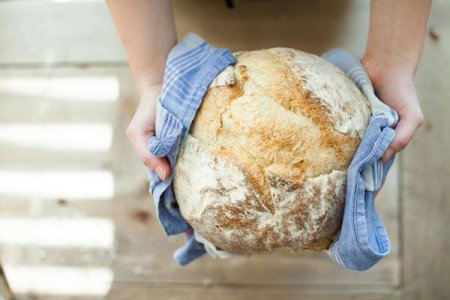Revive your stale bread instantly with this astonishing trick–You won’t believe how simple it is!
- Replies 0
Ah, bread—the staple of life, the centerpiece of the table, the comfort in our cupboards. But what happens when that once-crisp crust turns as tough as a crossword puzzle on a Sunday morning?
At The GrayVine, we understand that for our seasoned readers, every slice of bread is a page in the story of a well-lived life, and wasting it is simply not an option. So, how can you save your stale bread?
Before you consider tossing that loaf to the birds, let's talk about a miraculous revival that will breathe new life into your stale bread. It's a trick so simple, you might just shake your head in disbelief.
First, let's slice into the science of staleness. When bread is exposed to air, the starch molecules within begin to crystallize.
This process sucks the moisture out of the gluten molecules, leaving your bread stiff and dry. It's a natural occurrence, but it's not the end of the loaf's journey—not by a long shot.

The secret to resurrecting your bread lies in one humble ingredient: water.
Yes, the same stuff that makes plants grow and tea brew can also turn your bread from brick-like to bakery-fresh.
It may sound counterintuitive—after all, who rinses their bread? But trust us, a little water can work wonders.
Here's how to perform this culinary revival act:
1. Preheat your oven to a cozy 325 degrees Fahrenheit.
2. Hold your stale loaf under a gentle trickle of water, just enough to moisten the crust without making it soggy.
3. Place the dampened bread in the oven and bake for about 5 minutes. The heat will reinvigorate the bread, driving the water deep into the crumb, restoring its lost moisture.
4. Remove the bread and let it cool. The result? A loaf that's as inviting as a warm hug from an old friend.
If you're a connoisseur of crust and texture, feel free to experiment.
Some of those who tried this have found that a lower temperature and a longer bake yield a softer crumb, while others prefer a quick toast for a crunchier bite. The beauty of this trick is its adaptability to your personal palate.
Of course, the best way to combat staleness is to avoid it altogether. Proper storage is key—keep your bread in a cool, dry place, and seal it up tight to keep the air at bay.
But life is unpredictable, and sometimes a loaf gets left out. When that happens, you now have a trick up your sleeve.

Will you try this bread revival trick? Do you have your own methods for keeping bread fresh? Share your stories, tips, and questions in the comments below!
At The GrayVine, we understand that for our seasoned readers, every slice of bread is a page in the story of a well-lived life, and wasting it is simply not an option. So, how can you save your stale bread?
Before you consider tossing that loaf to the birds, let's talk about a miraculous revival that will breathe new life into your stale bread. It's a trick so simple, you might just shake your head in disbelief.
First, let's slice into the science of staleness. When bread is exposed to air, the starch molecules within begin to crystallize.
This process sucks the moisture out of the gluten molecules, leaving your bread stiff and dry. It's a natural occurrence, but it's not the end of the loaf's journey—not by a long shot.

Stale bread can be easily revived by lightly rinsing it with water and then baking it in the oven. Image source: Pixabay / Pexels.
The secret to resurrecting your bread lies in one humble ingredient: water.
Yes, the same stuff that makes plants grow and tea brew can also turn your bread from brick-like to bakery-fresh.
It may sound counterintuitive—after all, who rinses their bread? But trust us, a little water can work wonders.
Here's how to perform this culinary revival act:
1. Preheat your oven to a cozy 325 degrees Fahrenheit.
2. Hold your stale loaf under a gentle trickle of water, just enough to moisten the crust without making it soggy.
3. Place the dampened bread in the oven and bake for about 5 minutes. The heat will reinvigorate the bread, driving the water deep into the crumb, restoring its lost moisture.
4. Remove the bread and let it cool. The result? A loaf that's as inviting as a warm hug from an old friend.
If you're a connoisseur of crust and texture, feel free to experiment.
Some of those who tried this have found that a lower temperature and a longer bake yield a softer crumb, while others prefer a quick toast for a crunchier bite. The beauty of this trick is its adaptability to your personal palate.
Of course, the best way to combat staleness is to avoid it altogether. Proper storage is key—keep your bread in a cool, dry place, and seal it up tight to keep the air at bay.
But life is unpredictable, and sometimes a loaf gets left out. When that happens, you now have a trick up your sleeve.
Key Takeaways
- Stale bread can be easily revived by lightly rinsing it with water and then baking it in the oven.
- Preheating the oven to 325 degrees Fahrenheit and baking the rinsed bread for 5 minutes can restore its freshness.
- The process works because the added moisture replaces what the bread lost as it went stale, and the heat from the oven helps to redistribute this moisture.
- To avoid bread going stale, proper storage is recommended, but if it does happen, a quick rinse and bake can be a highly effective solution.
Will you try this bread revival trick? Do you have your own methods for keeping bread fresh? Share your stories, tips, and questions in the comments below!






